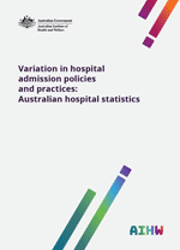Summary
For the last 3 decades, hospital statistics have been compiled by the Australian Institute of Health and Welfare on a national basis. The implementation of national standards and definitions has improved greatly the quality and comparability of hospital data over time; however, differences in definitions and recording still exist. This report describes variation in hospital admission policies and practices and how these differences may be impacting on data reported. Drawing on both quantitative analysis and input from a range of stakeholders, it is a valuable resource for data users interested in understanding more about the comparability of Australia’s national hospital data, and how best to use and interpret the data.
Key messages
The clinical needs of patients are paramount in determining the most appropriate pathway for their care. Variation in admission practice can reflect variation in administrative or funding arrangements rather than the nature of clinical care provided to similar patients.
For overnight-stay patients, there was limited evidence of hospital admission practice variation, with data consistency and comparability being relatively good.
Variation in same-day hospital admission was greater, and mostly reflected local admission policies and practices.
Variation in same-day acute care was particularly identified for (but not limited to) chemotherapy, endoscopy and dialysis.
Variation in same-day admission practice for subacute care (for example, rehabilitation) was also evident, particularly influenced by different admission practices between the private and public hospital sectors.
Same-day care provided in private day hospitals may differ from that provided in other private hospitals.
Recommendation
This report is specific to the reporting period 2013–14; the nature and extent of variation identified here may differ from that for other reporting periods, as may the variation in policies and practices that underlie it. For example, a service delivery model may change, a new policy may be introduced, or data quality improvements may be made by jurisdictions and/or individual hospitals. For this reason, there would be value in regularly updating this report (for example, biennially), and conducting a more comprehensive review of admission practice variation less regularly (for example, every 5 years).
Since the conclusion of this work, states and territories have agreed to provide admission and separation time on a best endeavours basis for the national hospital data collection. When these data are available, interpretation of admitted patient activity should be easier because short-stay admissions (for example, admissions less than 4 hours) will be able to be identified. At a national level, stakeholders have also agreed to consider other issues identified in this report as part of ongoing national hospital data development work.
Preliminary material: Acknowledgments; Abbreviations; Symbols
1 Introduction
- Background
- Why is this important?
- This report
- Understanding admitted care data
- Pathways to admission
- Sources of variation
- How variations influence performance reporting
2 Contextual factors that affect hospital admission
- Admission policies, legislation and data standards
- Models of service delivery
- Location of hospital and availability of other health services
- Funding models
3 Admission criteria in detail: points of variation
- Acute care
- Non-acute care
- Other points of variation
4 The transition between non-admitted emergency care and admitted care
- Points of variation
5 Outcomes of this work
- Measurement of the duration of admitted care
- Other related work underway
Appendix A: Additional material referenced in report
End matter: Glossary; References; List of tables; List of figures; List of boxes; Related publications



